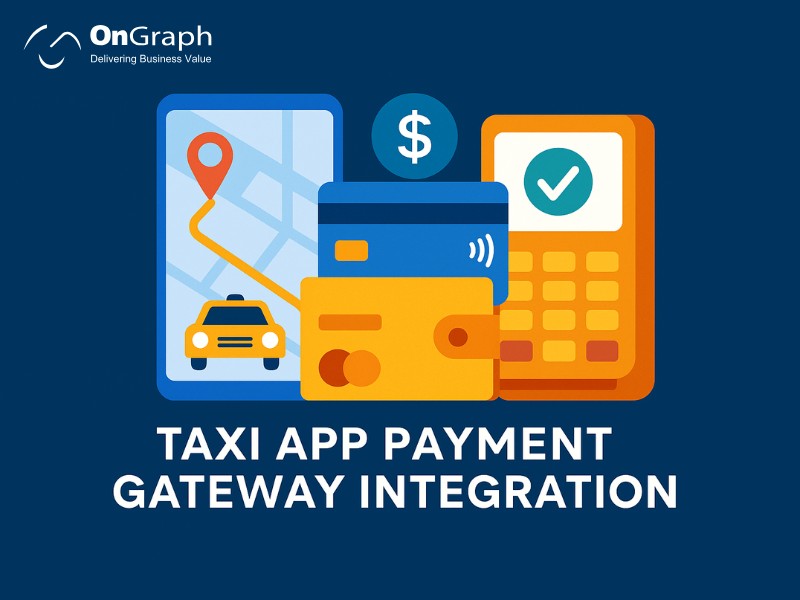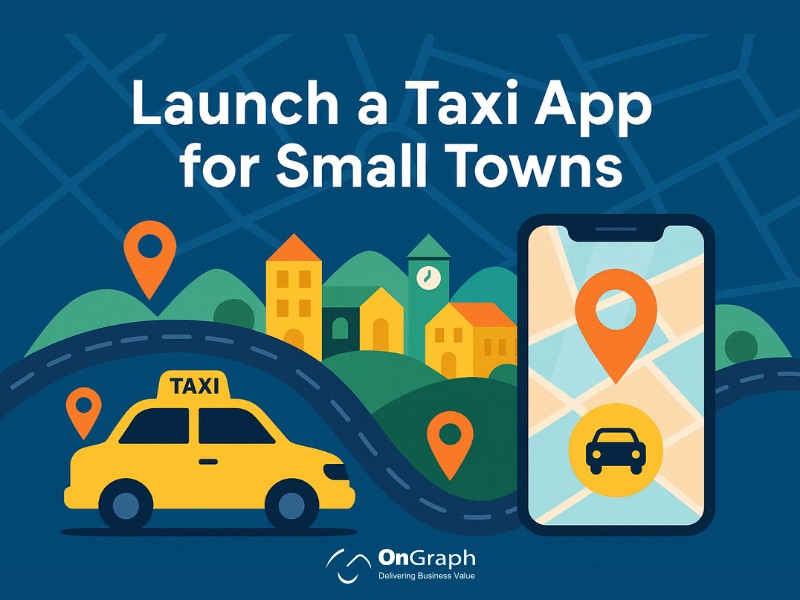In this article
- Why Digital Payments Matter in Ride-Hailing Apps?
- How Payment Gateway Integration Works in Taxi Apps?
- Choosing the Right Payment Gateway for Your Taxi App
- PayPal Integration in Taxi Apps
- Card Payment Integration for Taxi Apps
- Wallet Integration for Taxi Apps
- Step-by-Step Guide: Taxi App Payment Gateway Integration
- Taxi App Development Cost for Payment Integration
- Key Taxi App Features Required for Smooth Payments
- Major Payment Deployment Challenges in Taxi Apps
- Case Example: Small City Taxi Operator
- The Evolution of Taxi Apps and the Future of Digital Payments
- Conclusion
Adding seamless digital payments is essential for modern ride-hailing platforms. Riders expect fast, secure, and cashless payment options in every region. This makes taxi app payment gateway integration a critical step for any business building or scaling a mobility platform.
Today’s travelers carry fewer physical wallets, and over 65% of global consumers prefer digital payments over cash for transport services. This shift has changed the way taxi businesses operate.
Ride-hailing companies now rely on digital payment solutions to reduce cash handling, improve customer trust, and automate payouts.
Features like wallet systems, credit card payments, real-time fare deductions, and refund automation have turned payment integration into a core part of Taxi App Features.
This guide explains how to add card payments and wallets to your taxi app using best practices from leading payment providers. You will also learn about costs, security measures, and challenges during deployment.
Why Digital Payments Matter in Ride-Hailing Apps
Digital payments are now standard in mobility platforms. Global revenue for digital payments reached $11.55 trillion in 2024, and the market continues to grow at over 14% CAGR.
Transport services account for a major share because urban riders depend on apps for daily commuting.
Key benefits of digital payment solutions for ride-hailing
- Faster checkout increases user satisfaction.
- Reduces cash risk for drivers.
- Enables automated surge pricing.
- Helps track earnings with real-time visibility.
- Enables new features like subscription rides and pre-paid trips.
A cashless payment taxi app offers higher retention because riders trust transparent billing. Drivers also prefer automated payouts because they avoid handling cash. This trend is visible in The Evolution of Taxi Apps, where payments have moved from cash-only to fully digital.
How Payment Gateway Integration Works in Taxi Apps
To understand taxi app payment gateway integration, let us break the process into simple steps. A payment gateway acts as a secure bridge between the rider, the bank, and the ride-hailing platform.
The three major components
1. Rider App – Allows users to add cards, wallets, or PayPal accounts.
2. Payment Gateway – Processes and verifies transactions.
3. Driver & Admin Dashboard – Tracks payouts, commissions, and refunds.
Transaction flow
1. A rider confirms the ride.
2. The app sends a payment request to the gateway.
3. The gateway verifies the payment method.
4. Funds are authorized and held until the ride ends.
5. The final fare is charged.
6. The gateway transfers the revenue to the business account and driver wallet.
Security checks like tokenization, fraud detection, and encryption run in the background. They ensure secure payment processing for taxi operations.
Choosing the Right Payment Gateway for Your Taxi App
Selecting a gateway is one of the most important decisions for any Taxi App Development Company. The choice affects transaction fees, availability, onboarding speed, and user trust.
Top payment gateways used in ride-hailing apps
- Stripe – Best for global coverage and fast onboarding.
- PayPal – Trusted brand; good for international riders.
- Adyen – Enterprise-grade solution for mobility startups.
- Braintree – Supports cards, wallets, PayPal, and Venmo.
- Razorpay & Paytm – Ideal for India-based operators.
PayPal Integration in Taxi Apps
Many small taxi businesses rely on PayPal because riders trust the brand. With a PayPal integration taxi app, users can pay using their PayPal balance, cards, or linked bank accounts.
Why PayPal works well for taxi apps
- Strong fraud detection and buyer protection.
- Easy global refunds.
- One-tap payments for repeat riders.
- Fast business account settlement.
PayPal also supports payout features that help automate driver earnings.
Card Payment Integration for Taxi Apps
Credit and debit card support is essential for a professional ride-hailing experience. The integration usually includes:
Core elements
- Card Tokenization – Stores encrypted tokens instead of card numbers.
- Authorization Hold – Holds funds before the ride starts.
- Final Settlement – Charges the final amount after trip completion.
- Refund APIs – Handle cancellations.
Banks follow strict PCI-DSS rules to ensure data safety. This strengthens the trust factor in secure payment processing taxi operations.
Wallet Integration for Taxi Apps
Wallet systems are growing rapidly in mobility apps. Over 2.8 billion users worldwide use digital wallets every month. A wallet helps riders pay instantly without entering card details.
Benefits of wallet integration
- Faster checkout.
- Cashback and reward campaigns.
- Offline transaction handling.
- Support for small-value rides in local markets.
Some ride-hailing apps even offer an internal wallet for loyalty programs.
Step-by-Step Guide: Taxi App Payment Gateway Integration
Below is a simple, actionable approach used by leading tech teams.
Step 1: Choose supported payment methods
Decide which options your audience prefers:
- Debit and credit cards
- Wallets
- UPI
- Net banking
- PayPal
- QR payments
Small local operators often start with cards and wallets because of low integration effort.
Step 2: Create merchant accounts
Every payment gateway requires business verification:
- Business registration documents
- Bank account details
- Identity verification
- Operational proof
Approval takes 1–7 days depending on the region.
Step 3: Integrate SDK or APIs
Your developers will integrate the payment SDK into:
- Rider App (iOS + Android)
- Backend (Node.js, Laravel, PHP, or other stack)
- Admin panel
This step includes:
- Adding payment UI
- Setting server endpoints
- Adding transaction status hooks
- Wallet sync logic
- Fare calculation API adjustments
This is the most important part of taxi app payment gateway integration.
Step 4: Add security layers
Security is essential for compliance and trust. Add:
- SSL
- PCI-DSS compliant servers
- Tokenization
- User authentication
- Fraud detection rules
- 3D secure
- OTP verification
These steps prevent credit card fraud and improve user confidence.
Step 5: Enable auto-settlement for drivers
Modern taxi apps automate payouts. Funds are split between:
- Driver earnings
- Platform commission
- Taxes
This helps reduce errors and improve transparency on both sides.
Step 6: Add testing and sandbox validation
Payment gateways provide sandbox accounts. These help test:
- Successful payments
- Failed transactions
- Refunds
- Currency conversions
- Surge pricing
- Scheduled rides
- Wallet top-ups
Testing prevents major Taxi App Deployment Challenges when the app goes live.
Step 7: Launch and monitor payments
Monitor key metrics after launch:
- Payment success rate
- Refund ratio
- Failed card attempts
- Integration errors
- Settlement delays
Strong payment monitoring keeps revenue stable.
Taxi App Development Cost for Payment Integration
Integrating payments affects the total Taxi App Development Cost. The actual cost varies depending on features, API requirements, and supported methods.
Approximate cost ranges
- Card payments integration: $800–$1500
- Wallet integration: $1200–$2500
- PayPal integration: $600–$1200
- Backend settlement logic: $800–$1500
- Testing and QA: $300–$700
A full-featured solution can cost between $4000 and $8000 for payment workflows alone. The total taxi app cost increases depending on customizations, local rules, and deployment requirements.
Key Taxi App Features Required for Smooth Payments
To ensure a complete digital payment experience, integrate the following features:
Rider-side features
- Save cards
- Wallet top-ups
- Pre-authorization
- Auto fare deduction
- Payment history
- Refund notifications
Driver-side features
- Earnings wallet
- Withdrawal request
- Transaction history
Admin features
- Settlement dashboard
- Commission rule setup
- Manual refund options
- Failed transaction logs
- Payment reporting tools
These features reduce payment friction and build long-term loyalty.
Major Payment Deployment Challenges in Taxi Apps
Even mature apps face Taxi App Deployment Challenges during payment integration. Common issues include:
1. Regional restrictions
Some gateways do not support all countries.
2. High failure rates during peak hours
Traffic spikes can affect API response times.
3. Multi-currency issues
International riders need currency-specific support.
4. Bank downtimes
Bank servers may fail during heavy load.
5. Fraud attempts
Taxi apps are high-volume platforms and require strong fraud detection.
6. Driver payout delays
Settlement rules differ across gateways.
A professional Taxi App Development Company handles these challenges through monitoring, API fallback systems, and redundant payment flows.
Case Example: Small City Taxi Operator
A small taxi operator in a mid-sized city added card and wallet payments to reduce cash handling. Within six months, they reported:
- 48% increase in repeat bookings
- 65% reduction in cash-related disputes
- 30% faster trip completion time
- Higher trust from new riders
The operator expanded from two to eight vehicles after integrating digital payments.
This example shows how taxi app payment gateway integration can transform small mobility businesses.
The Evolution of Taxi Apps and the Future of Digital Payments
Taxi apps have evolved from simple call-booking services to intelligent mobility platforms. Payments have moved from cash to:
- Digital wallets
- Contactless cards
- QR payments
- Crypto wallets (in some regions)
- Auto-charge subscriptions
Future trends include:
- Pay-per-mile subscriptions
- AI-based fraud detection
- Ride credit trading within wallet systems
- Instant payout systems
Digital payments will continue to shape the future of taxi and ride-sharing businesses.
Conclusion
Payment integration is the backbone of a scalable taxi app. Riders expect fast, secure, and seamless transactions.
Integrating cards, wallets, and PayPal strengthens revenue, improves customer trust, and modernizes your operations.
With the right strategy and technical approach, taxi app payment gateway integration can help you build a future-ready mobility platform that works in any market.
If you plan to build or upgrade your taxi app, choosing an experienced team ensures a smooth launch and avoids costly deployment issues.
FAQs
It is the process of connecting your taxi app with a digital payment provider. The integration handles card payments, wallets, PayPal, and bank transfers. It ensures fast, secure, and automated fare collection.
Simple integration takes 3–7 days. Complex integrations require 2–3 weeks. Timelines depend on supported payment methods, backend logic, and security requirements.
Top gateways include Stripe, PayPal, Razorpay, Braintree, Adyen, and Paytm. The choice depends on region, supported currencies, and business size.
The rider adds a card, which gets converted into a secure token. A hold is placed before the ride. The app charges the final fare after trip completion.
Wallets improve user experience by allowing faster payments. They also enable cashback, loyalty points, and offline payment scenarios.
Basic integration costs $1500–$3000. Advanced setups with wallets, refunds, and settlements cost $4000–$8000.
Yes. Gateways use tokenization, encryption, 3D secure, and fraud detection systems. Following PCI-DSS guidelines ensures maximum safety.
About the Author
Let’s Create Something Great Together!
Latest Blog















